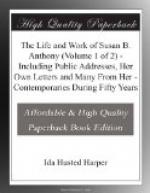A letter from Phoebe Couzins expressed the sentiment of numbers which were received this spring: “We made a grand mistake in giving up the National. If you and Mrs. Stanton think best, as your fingers are on the pulse of the people, let us resolve the Union Society into the National Association. So say Mr. and Mrs. Minor, but whatever is done, the two grand women who have the qualifications for leadership must be at the head; the cause will languish until you are back in your old places.”
The suffrage anniversary was held in Apollo Hall, New York, May 11 and 12, 1871. Mrs. Griffing read an able report on the work at Washington the previous winter. There were strong objections by a number of ladies to sitting on the platform with Mrs. Woodhull, but Mrs. Stanton said she should be sandwiched between Lucretia Mott and herself and that surely would give her sufficient respectability. She made a fine constitutional argument, to which the most captious could not object. The excitement created by her appearance at the Washington meeting was mild compared to that in New York City where she was becoming so well-known. The great dailies headed all reports, “The Woodhull Convention.” The injustice and vindictiveness of the Tribune, that paper which once had been the champion of woman’s cause, were especially hard to bear. It rang the changes upon the term “free love,” insisted that, because the women allowed Mrs. Woodhull to stand upon their platform and advocate suffrage, they thereby indorsed all her ideas on social questions, and by every possible means it cast odium on the convention.
There is no doubt that the advocates of “free love,” in its usually accepted sense, did endeavor to insinuate themselves among the suffrage women and make this movement responsible for their social doctrines, but every great reform has to suffer from similar parasites. The lives of Miss Anthony, Mrs. Mott, Mrs. Stanton, Mrs. Hooker, Mrs. Davis, and of all the old and tried leaders in this cause, form the strongest testimony of their utter repudiation of any such heresy. It was impossible, however, for the world in general to understand their broad ground that it was their business to accept valuable services without inquiring into the private life of the persons who offered them. If this were a mistake, these pioneers, who fought single-handed such a battle as the women of later days can not comprehend, had to learn the fact by experience.




